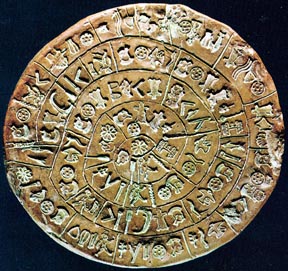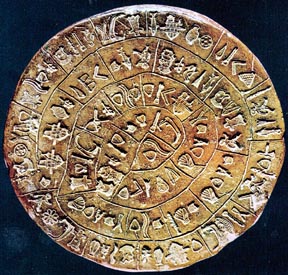Palace at Phaistos
The excavations of Phaistos were begun by the Italians in 1900. The first palace was built around 2000 BCE; as at Knossos, it was destroyed around 1700. The second palace was then built, set back from the first, which survived until about 1450 BCE and then abandoned.
The setting for the palace at Phaistos, on a steep hilltop looking north from Mount Ida, is more beautiful than for Knossos. The plan is also more symmetrical and regular compared to Knossos.

Plan of the Palace at Phaistos

Phaistos Disk: Side A

Phaistos Disk: Side B
Phaistos Disk
terracotta
Diameter 6 inches; Thickness 1 inch
c. 1600 BCE
(Archaeological Museum, Herakleion, Crete)
Both sides of the so-called Phaistos Disk are covered with 242 signs impressed into the clay with wooden stamps or sealstones and arranged in a spiral pattern from the edge to the centre. The signs belong to an ideographic and probably syllabic script which has not yet been deciphered despite the numerous attempts over the years. The exact date of the disk is also questionable, but it probably dates from the MM IIB period.

 SPRING 2016
SPRING 2016  SCHEDULE
SCHEDULE  REQUIREMENTS
REQUIREMENTS

 SPRING 2016
SPRING 2016  SCHEDULE
SCHEDULE  REQUIREMENTS
REQUIREMENTS